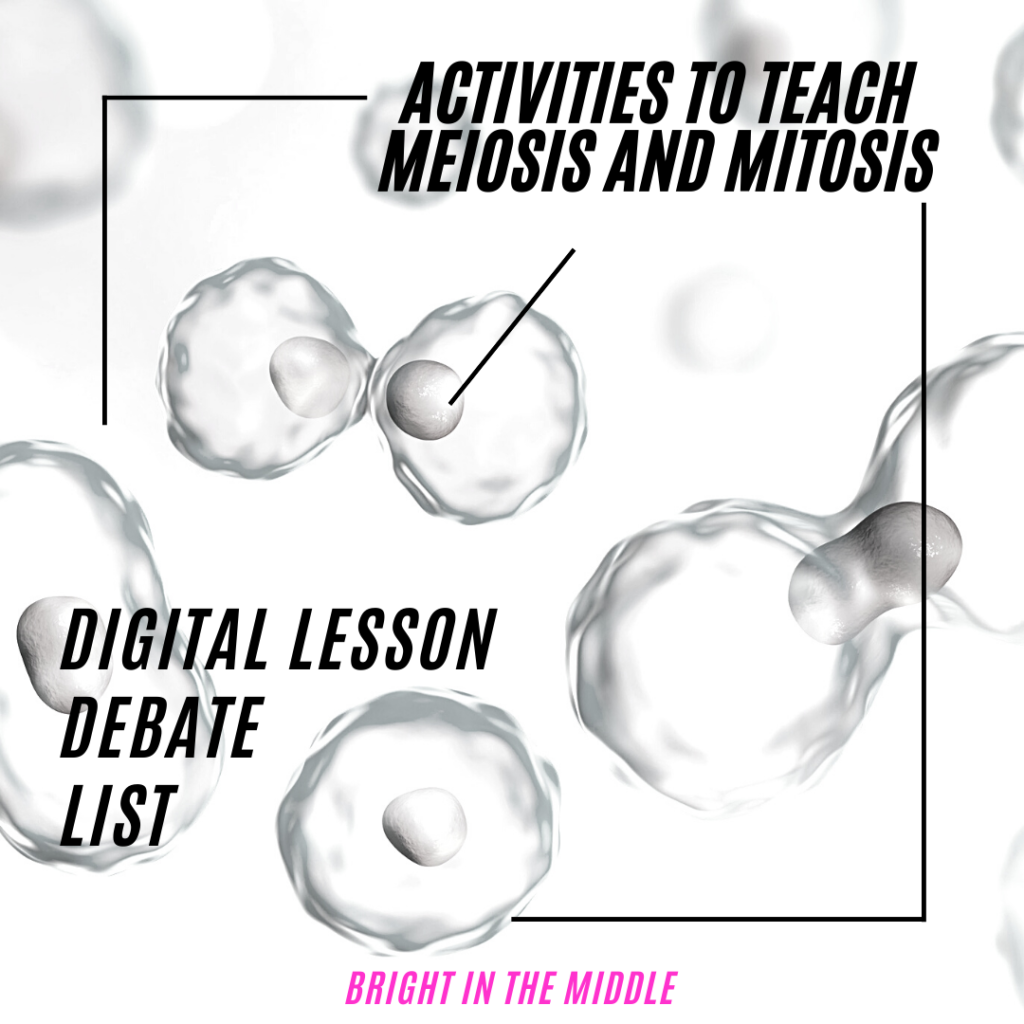I will be the first to tell you that I LOVE biology and life science; however, mitosis and meiosis can be a bit dry and overwhelming. There are so many stages, so much vocabulary, and it can be SUPER confusing, especially to a middle school student that is hearing all of this stuff for the first time. It can also be difficult to determine the differences between these processes.
With any topic though, especially in science, it can be made fun! And with the secret sauce, students will be engaged and remember what they have learned!
In this blog post, I’d like to tell you, first, of how these two processes are similar and different. Second, I’d like to share with you how you an easy way to remember the difference between the two. Finally, I want to share some activities and resources that you can use to make this lesson successful in your middle school science classroom!

How are Meiosis and Mitosis Similar and Different?
There are many key differences as well as similarities between these processes.
First of all, let’s talk about what these processes even are! Mitosis is the process in the cell cycle where the body makes body cells, and meiosis is the process of making sex cells (gametes).
So, what are the similarities between meiosis and mitosis?
Both:
- involves cell reproduction
- creates new cells
- can be divided into four substages
- start with diploid parent cell
What is the difference between these processes?
- Mitosis creates identical body cells, and meiosis makes nonidentical sex cells.
- Mitosis produces 2 cells, and meiosis produces 4 cells.
- The function of mitosis is growth and repair, and the function of meiosis is genetic variety/reproduction.
- Mitosis goes through PMAT once, and meiosis goes through PMAT twice.
- Mitosis produces diploid cells, and meiosis produces haploid cells.
- In mitosis, the daughter cells have 46 chromosomes, and in meiosis, the daughter cells have 23 chromosomes.
How To Remember Meiosis and Mitosis
I will NEVER forget the functions of these processes thanks to my 10th grade biology teacher. She had a little phrase that she used to say all of the time that has stuck with me to this day!
So what is this saying that will help your students forever?
Mitosis makes my body, and meiosis makes me! However, although not right, you must say meiosis as “me” osis! It helps it stick!

Activities To Teach the Difference Between Meiosis and Mitosis Stages
Digital Interactive Lessons
Digital Interactive Lessons are GREAT for reducing cognitive load and engaging your students in whatever science topic that they are learning about.
These lessons are great for direct instruction, self-paced learning, science centers, review, small groups, partner work, and so much more!
In this mitosis and the cell cycle lesson, students can learn or review the cell cycle, the purpose of mitosis, DNA, chromosomes, PMAT, interphase, cytokinesis and more using digital activities like drag-and-drop, matching vocabulary, answering in the textbook, and more, via PPT or Google Slides.
In the meiosis digital interactive lesson, students can learn or review about an overview of the phases of meiosis, the purpose of meiosis genetic variety, and the differences and similarities between mitosis and meiosis.
There is a chart that students can fill out to organize their knowledge of how these two processes are different.
Which is More Important – Mitosis or Meiosis Debate
Another thing to help students determine and remember these processes and the similarities and differences between them is to have a DEBATE! A debate is one of my favorite middle school science engagement strategies.
You can either assign students a side, or they can pick a side to answer the question: Which is the most important – Mitosis or Meiosis?
Students can research and take notes before the big event. This is a great opportunity to talk about classroom management, not talking over others, and having an organized conversation with purpose!
List Out the Differences between Mitosis and Meiosis
This gives the students another opportunity to do some research of their own. You could have your students to create a list of all of the differences (and similarities) between these processes!
How should you do this? Well, I’m all about a competition!
You could set a timer for 30 minutes. Tell students to use textbooks, a partner, the internet etc., and come up with the greatest list of the differences between the two processes. Winner gets a prize!
Students will probably come up with some differences that are not covered in middle school content, however, this will not hurt them at all!
After, you could point on the most important for your particular standard.
Extra: Mitosis and The Cell Cycle Gallery Walk
Are you just teaching mitosis and the cell cycle at the moment? Gallery walks are great for covering topics with a lot of “pieces”. This mitosis and the cell cycle gallery walk covers all of the processes of the cell cycle including interphase, prophase, metaphase, anaphase, telophase, and cytokinesis.
Students can walk around the room with their recording sheet and take notes on each of these phases writing down a short definition, a brief description, fun facts, and pictures!
I love gallery walks!
More Resources to Explain the Difference Between Meiosis and Mitosis
Interested in more resources? Check these out!
Help your students master science content!



This is wonderful. I will be purchasing.
Thank you! I hope you find these ideas helpful!